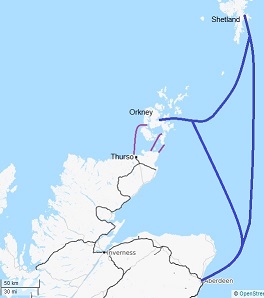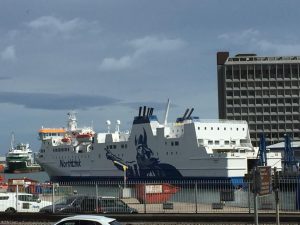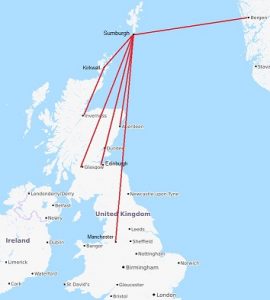This page provides information about getting to Shetland and getting around – although always check the official sites; information can become outdated pretty fast!
Shetland is a long way from the UK mainland, so getting there is never going to be quick. Unlike many other UK islands, which are just a ‘hop and a jump’ away, this is a big trip out to the edge of the Atlantic. Combine the distance with the lack of competition (a population of around 23,000, so there isn’t really a big enough market) and fares aren’t cheap, either… but worth it. Planned well, the trip to Shetland will become part of your island experience.
Getting to Shetland by Sea
Sea routes from the UK mainland to Shetland
Arriving by sea is the ‘traditional’ way, and is heartily recommended. It also means you can take your car with you, if need be. Routes are operated by Northlink Ferries, with daily departures from Aberdeen, on alternate days going via Kirkwall in Orkney:
- Aberdeen – journey time 12-14 hours. If this sounds long, don’t worry, it’s actually very practical. The boat leaves Aberdeen in the evening and arrives in Shetland next morning, so the boat becomes your hotel. (The same timings apply in the reverse direction.)
- Kirkwall – journey time 7-8 hours. A shorter crossing, though of course you must first get to Orkney from the mainland UK…! Sea routes from mainland Scotland to Orkney vary, between 45 and 90 minutes, with different operators:
- Northlink Ferries Scrabster to Stromness
- Pentland Ferries, Gills Bay to St. Margaret’s Hope
- John O’ Groats Ferry, John O’ Groats to Burwick (seasonal, foot passengers only)
The ferries that serve Shetland, the Hrossey and Hjaltland, are comfortable well-run ships to travel on (I speak from experience), with excellent crews. Certainly these aren’t cruise ships – they’re an island lifeline- but have a great quality of service. Facilities include a restaurant, bar/cafe, a shop, cinema, cabins and lounges.
As of February 2022, passenger fares are as follows. A single each way is £23-£36 and cabin supplements start at £63-£93 each way. If taking a car this is roughly £95-£127 each way.
Tips for the sea journey
- Book your trip well in advance, especially if taking a car. Spaces sell out quickly for popular times of the year!
- Book a cabin for the trip. Yes it’s expensive, but worth every penny on such a long crossing. (Pre-COVID, there was a cheaper option where you could opt to share a cabin, but this has yet to return.)
- The ferries arrive about 7:00 am, but if you’re a foot passenger, you can stay on board enjoying breakfast until 8:00-8:30 am. (Pre -COVID car passengers could pay to have their vehicles driven off for them, but this has yet to return).
- If you’re travelling via Aberdeen as a foot passenger, book your rail tickets well in advance for the best deals. A luxurious option if you’re coming from England is to get the overnight Caledonian Sleeper to Aberdeen; spend the day exploring the Granite City before checking in for the ‘North boat’.
Finally, the big question… What if I’m seasick? ALL first-time visitors ask me this! First of all (and obviously) don’t convince yourself you are likely to be. This is a beautiful crossing, often with calm weather. The boats are fitted with stabilisers, and their skippers are well used to taking the route that makes things most comfortable for their passengers. Secondly, if you have suffered from seasickness before, take a tablet before travelling or use travel sickness bands. If you really are nervous, have a sensible meal and drink as soon as you’re on board, and make an early night of it. The first few hours out of Aberdeen are usually calm. By the time you wake up the ship will be nearing Lerwick.
Shetland by Air
Air routes to Shetland in 2019 – not all routes may yet have resumed.
The trip to Shetland by air is a lot quicker than the boat (well, obviously), and although it doesn’t offer quite the same experience, arrival Sumburgh airport is a wonderful introduction to the islands. Take a look at this youtube video, showing the pilot’s view, to see what I mean.
All flights are currently operated by Loganair, who fly from a number of airports to Shetland, including:
- Aberdeen (1 hour)
- Edinburgh (1 hour 30)
- Glasgow (1 hour 15)
- Orkney (45 mins)
- Inverness (1 hour 45, via Orkney)
Other links which operated pre-COVID (and which may resume) include Manchester and Bergen in Norway.
In addition to the airports shown, you can also book through tickets to Shetland from airports served by British Airways.
Don’t be too surprised if your plane to Shetland has propellers…! Despite first appearances, these are modern and efficient turboprops. These planes are far better suited to the many different island airports Loganair serves, many of which are much smaller than Sumburgh, where in many cases a jet could not operate. Note that Loganair is one of the airlines where you can still usually expect a free in-flight cuppa!
Tips for flying to Shetland
- Book as far in advance as you can, airline pricing always seems more of an art than a science! Currently fares from Aberdeen to Sumburgh start at about £90 one way, including taxes.
- Book your car hire through one of the local firms rather than the international chains (for which they are usually a franchise in any case) – you will often get a better deal. See below, under Getting Around
- Make sure you have travel insurance to cover flight delays. Sumburgh is a well-run airport, but the Shetland weather can mean fog or extreme winds occasionally disrupt operations.
- …And of course, make sure you leave enough time to get back to Sumburgh for your return flight. The airport is some 25 miles from the islands’ capital, and check in deadlines are as scrupulously observed as anywhere!
Getting around Shetland
Shetland by Bus
It is possible to explore many of Shetland’s highlights by using its public transport network, although some parts take a bit of careful planning. Timetables can be found at www.zetrans.org.uk. The network is largely centred on Lerwick, and fares are cheap – £2.90 for the 25 miles to the airport. As a rough guide, the following describes the network, but always check the official Zetrans website.
- Lerwick to Scalloway – buses roughly hourly
- Lerwick to the South Mainland & Sumburgh Airport – buses roughly every 2 hours
- Lerwick to the West Mainland and Walls – 6 buses a day
- Lerwick to Voe and Brae – buses roughly every 2 hours
- Lerwick to Hillswick – 3 buses a day
- Lerwick to Vidlin for the Isle of Whalsay – 4 buses a day
- Lerwick to the North Isles (Yell, Unst & Fetlar) – 1 a day (you will need to stay overnight!)
- Other services exist, often as a guaranteed connection to the ‘main line’ routes above.
Rough outline of Shetland bus services
Of course, you needn’t be stranded. If a bus service can’t take you where you want to go, there are plenty of taxis across the islands; many of which also act as guides.
Shetland Car Hire
Hiring a car will give you more flexibility on your trip. Many of the roads are in very good condition, although some in more remote areas are single track with passing places. As a general rule, it is better to book direct with one of the local firms to get the best rates; these include:
- Star Rent-A-Car (local Europcar and Alamo agent)
- Bolts Car Hire (local Avis agent)
- Grantfield Garage
Many of these can arrange to meet you at the port or airport.
As with many areas around the UK, rural filling stations can be thin on the ground outside Lerwick, so plan ahead – the Tourist Information Office will have full details.
Shetland by bicycle
For those feeling active it’s easy to explore Shetland by bike (although maybe not on days when there’s ‘a bit of a wind’). Outside of Lerwick’s ‘rush hour’, the roads aren’t too busy, and the Tourist Office has leaflets with some ideal routes.
There’s a number of places that do cycle hire in the islands, including Eric Brown’s Cycles, but do enquire ahead if possible.
Inter-Island Ferries and Flights
Having taken so long to reach Shetland itself, it may seem strange to have to take another flight or ferry whilst you’re there! But if you want to visit many of the outlying isles (and you should) then that’s what you’ll end up doing. It’s not that difficult, though.
Bressay, Fetlar, Unst, Whalsay and Yell are linked by frequent car ferries operating short crossings (10-30 minutes).
Other islands are further out, and visiting them by their smaller ferries may involve an overnight stay (no bad thing); but Foula, Papa Stour and Fair Isle are also served by the Inter-Island Air Service from Tingwall Airport, just north of Lerwick.
Rough diagram of inter-island ferry routes
Page updated 06/02/22





